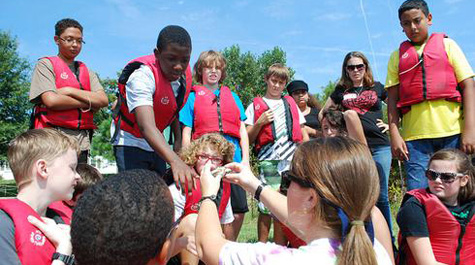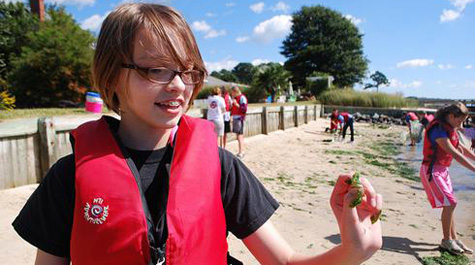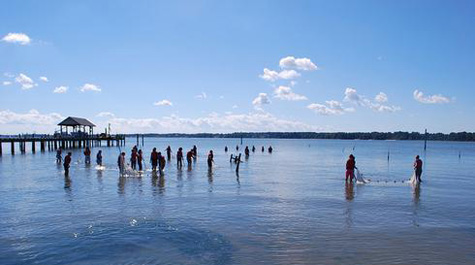Students share knowledge of Chesapeake Bay via Twitter
Seventh graders at Queens Lake Middle School in Williamsburg recently took learning to another level by using the popular social networking site Twitter to share what they learned about the nation’s largest estuary in 140 characters or less.
The students are a part of Chesapeake Studies for Virginia Middle Schools—a program offered by the Chesapeake Bay National Estuarine Research Reserve (CBNERR) at the Virginia Institute of Marine Science. Local middle schools use the program to address 7th-grade Virginia Standards of Learning (SOLs) for Life Science.
Started in 2005, Chesapeake Studies reaches every 7th-grade student in Gloucester, Mathews, and York counties, with programs at Peasley Middle School in Gloucester, Thomas Hunter Middle School in Mathews, and Queens Lake, Tabb, Yorktown, and Grafton Middle Schools in York. 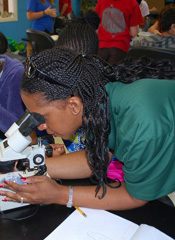
Funded by a series of one-year grants from NOAA’s Bay Watershed Education and Training Program (B-WET), the Chesapeake Studies project has reached nearly 5,000 students since its inaugural year. CBNERR Education Coordinator Sarah McGuire heads the effort and says, “We strive to make sure the students are aware of their local environment, and want the teachers to be aware as well so they can try to incorporate learning about the Bay into future lesson plans.”
The program combines a full day of field experience at VIMS, a pair of visits by CBNERR Education Specialist Jaclyn Miller to the student’s own classrooms, ongoing instruction by the students’ regular life-science teachers, and classroom aquaria for use in science experiments.
Learning and Tweeting
Queens Lake is the first of the six middle schools to finish the program for the current school year. As the program drew to a close, Jaimee Buckley—the 7th-grade life science teacher at Queens Lake— wanted to make sure her students could share what they were learning about the Bay with a larger audience in hopes of making a positive impact on members of the community.
After lots of brainstorming, Buckley decided to use Twitter because of the social network’s ability to use hashtags—a tool used to group messages with similar content.
“At each step of the Chesapeake Studies program, the students were reminded the program was established so that teachers and students could pass on the information that they had learned and share it with others,” says Buckley. Students without a Twitter account were able to write down what they would like to say, with a subscribed classmate tweeting it for them.
Buckley encouraged her students to tag their tweets with the hashtag #qlmscbv—which stands for Queens Lake Middle School Chesapeake Bay VIMS. Within a few hours, the students had grabbed the attention of institutions like VIMS and the Chesapeake Bay Foundation on their own Twitter accounts, who promptly began retweeting and tweeting responses to the students.
Over the next couple of days, Twitter was buzzing with tweets from the students, and their teachers and principal also joined the conversation. “Some students continued tweeting about what they had learned after school hours without even being asked,” says Buckley.
One student tweeted, “Hey guys, the Chesapeake Bay has a lot of habitats that we should protect. Protect the Bay!”, while a classmate asked, “Did you know the Chesapeake Bay is an important food source that we need to keep alive?”. While some students urged people to volunteer, others simply tweeted, “VIMS helped me see a different side of the Chesapeake Bay and science.”
“My students were so excited to use social media in the classroom,” says Buckley. “Every time they would get retweeted by VIMS or the hashtag would get mentioned by people they didn’t even know, you could see and feel the excitement in the classroom. Many of the students said they felt like they had been heard and thought they’d made a positive impact on Chesapeake Bay.”
Raising Awareness
The Chesapeake Studies program has inspired thousands of local students to do their part to help the Bay. Former participant Trevor Keener says, “The Chesapeake Studies program gives students an understanding of the environment and the importance of preserving this fragile ecosystem. I have personally gained an interest in pursuing a career in marine biology because of my many experiences with CBNERR at VIMS.”
Keener was attending Peasley Middle School when he got involved with the program. Now a student at Gloucester High School, he continues to pursue as many volunteer opportunities with CBNERR as his schedule will allow. “I think it’s really important to instill the importance of the Bay in today’s youth, and teach them the role we play in ensuring its future,” he says.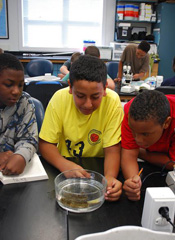
Queens Lake 7th-grader Sara Little says, “It’s important for kids to learn about Chesapeake Bay so they can realize how much we effect it. How would you like people dumping garbage in your home? We made the mess, so now we have to clean it up!”
CBNERR’s Education Specialist Jaclyn Miller spends most of her time in the classroom at each of the six participating schools. She says, “I’m a big advocate for awareness and how important it is for the students to know that they impact the environment just by living here.”
Meaningful Chesapeake Bay Watershed Experience
“The Chesapeake 2000 Agreement mandated that all students must have a meaningful Chesapeake Bay watershed experience before they graduate from high school,” says McGuire. “We chose to focus on the 7th grade because that’s when students learn about life science, which directly correlates with what we are doing in the program.”
Each student has the opportunity to gain field experience at VIMS during the program, which reflects some of the lessons they are learning in their life science classes. “While the students are at VIMS, they spend half their time in the laboratory and the other half in the water,” says McGuire. “They do lab activities using microscopes and dichotomous keys, which are often refreshers for them, and then they spend time seining and collecting samples in the York River.”
“The program has given a face to environmental concerns in our area,” says Buckley. “Students aren’t learning about some far-away place. They are learning about living and nonliving factors in their environment and that their actions can make a direct impact.”
The Future of Chesapeake Studies
Though York County schools were not added to the program until 2010, Peasley and Thomas Hunter have been involved in the program since its inception and have started to develop ways to make the program sustainable. “We’re trying to make sure the teachers who’ve been involved in the program have the resources to do the activities in their classrooms on their own,” says McGuire.
“Not only are the students getting a unique experience, but the teachers are also finding new ways to teach about what’s around them,” says Miller. “Increasing the teachers’ confidence by making them feel good about taking the kids on field experiences and know what activities to do is how we are making this program sustainable,” adds McGuire.
While funding may not be renewed for another year, McGuire and Miller are hoping to create a program similar to Chesapeake Studies, but catered to high school students. Regardless, the pair will continue to provide assistance to the middle school teachers.

